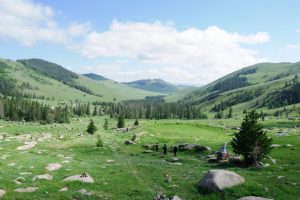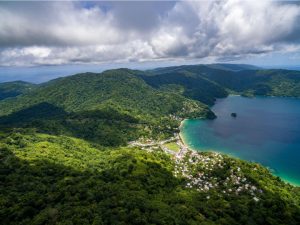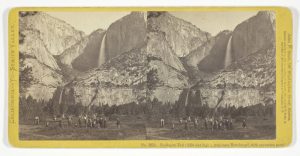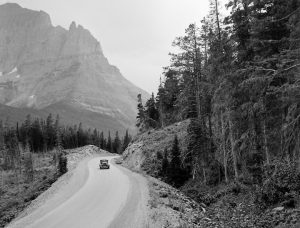On 1 March 1872, US President Ulysses Grant signed “An act to set apart a certain tract of land lying near the headwaters of the Yellowstone River as a public park.” The act prohibited the sale, settlement or occupation of the land with the penalty of forced removal for trespassers, and dedicated the park as a “pleasuring-ground for the benefit and enjoyment of the people”. Soon after, this land between Montana and Wyoming was designated as a “national park”, the first with this label. But Yellowstone was not the first protected natural area in the world, and many others have since been added to the national park designation, now totalling almost 262,000 officially protected areas, covering over 15% of Earth’s land surface and 7.4% of its oceans. This is the human effort to preserve threatened natural heritage.

The protection of natural areas goes back centuries. The first were for religious reasons, because of their sacred character. One such example is Bogd Khan Mountain, south of present-day Ulaanbaatar, the capital of Mongolia. In the 13th century, the Keraite leader Van Khan took the mountain under his protection as a sacred place, banning hunting and fire-making. This and other sites on the Mongolian steppe were perhaps the first areas to be protected by order of the authorities to preserve their natural beauty. In 1778, the governor of the newly founded city wrote to the Qianlong Emperor requesting that the mountain be protected and stationed 28 guards at the mountain passes to ensure that no one could enter without imperial permission. Some claim that Bogd Khan Uul National Park, a UNESCO Biosphere Reserve since 1996, is the oldest national park in history.
But while those Mongolian guards could be considered the first park rangers, another area disputes the primacy of the park. On the Caribbean island of Tobago, then a British colony, the central range of hills was granted protection in 1776 thanks to the efforts of the writer and member of the British Parliament Soame Jenyns, who had studied the work of his contemporary Stephen Hales on plant physiology, which showed a correlation between forests and rainfall. Jenyns was a member of the Trade Commission that parcelled out the island for plantations, and he believed that preserving the hill forest would keep the rains coming and maintain the fertility of the land. This chain was thus the first reserve for environmental purposes, before ecology existed as a science. In 1904, it was expanded to form the Tobago Main Ridge Forest Reserve, which became a UNESCO World Heritage Site in 2011.

Nor was Yellowstone the first protected natural area in the USA. Four decades earlier, the Hot Springs area of Arkansas, a national park since 1921, had been set aside as a federal reserve to protect its hot springs. But although the law signed by President Andrew Jackson in 1832 prohibited the use and appropriation of the land, the protection was only nominal, and settlement and business proliferated.
The struggle for exploitation
This case illustrates how, in the United States, the country that invented the modern concept of national parks—”America’s best idea”, according to the writer and environmentalist Wallace Stegner—the history of these spaces has always been a struggle between those who wanted to preserve them and those who coveted their riches. In 1831, the French historian Alexis de Tocqueville wrote to a friend urging him to visit Niagara Falls before it disappeared under the pressure of energy exploitation and tourism; at the time, cougars, bears, bison and wolves were sometimes sent over the falls in condemned boats to entertain the crowds. The falls were finally protected in 1885.

Something similar happened in California’s Yosemite Valley, which was also protected before Yellowstone, by an act of Congress signed by Abraham Lincoln in 1864 that ceded it to California as a state park. However, the lack of effective protection meant that the goal of conservation was not initially achieved. Eight years later, the Yosemite Act inspired the Yellowstone Act, although its federal protection, making Yellowstone a “national” park, was an accident due to disagreements between Wyoming and Montana.
Yellowstone did not get off to a smooth start either. Three formal expeditions had explored, mapped and studied its canyons, lakes, waterfalls and hot springs. William Henry Jackson’s descriptions and photographs of the landscape, and the paintings of Thomas Moran and Henry W. Elliot, sparked interest in its protection, spurred on by the likes of geologist Ferdinand Hayden and politician and businessman Nathaniel P. Langford. But designating the land as public ran counter to the policies of privatisation and colonisation. When Langford took over as the park’s first superintendent, he did so without pay, special legislation or funds to build basic infrastructure or hire rangers. It was not until 1878, under his successor Philetus Norris, that Congress appropriated funds to develop the park. But in those early years, Yellowstone’s history was written amid struggles against poaching, logging and squatting, and massacres of Native Americans.

The initiative soon spread to other countries. In 1879, Australia declared the world’s second national park, now the Royal National Park. This was followed by Banff in Canada (1885), Tongariro in New Zealand (1887), the first European parks in Sweden (1909), the first African park in Virunga (1925) and the first park in Asia (1936), now Jim Corbett National Park in India. Today the world’s national parks and nature reserves receive eight billion visitors a year, a number equal to the world’s population, and face the challenge of surviving in an overpopulated world.
Comments on this publication